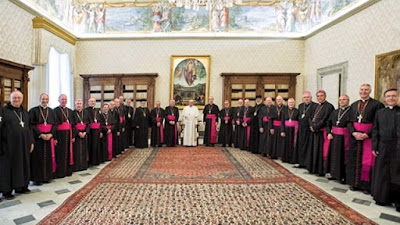Well, today started off with
a real treat for Bishop Greg and myself. Word had reached us through the week
that a group of students from Austin O’Brien Catholic School in Edmonton would
be in Rome for a couple of days. We learned that they had arranged to celebrate
Mass with Fr. Michael Schumacher in one of the chapels in the crypt area below
St. Peter’s Basilica. We wanted very much to see them, so we went over to the
Basilica first thing and met up with them as they were finishing their
celebration of the Mass. I must say, they are an ambitious group! They’re on a
twelve-day adventure that began in Barcelona and passed through Venice and
Orvieto (and probably a few other places that I didn’t catch) before coming to
Rome. No wonder they looked so tired! Happy, but a little fatigued. It was a
delight to be with them.
As it turns out, this
unplanned encounter set the stage beautifully for the meetings that had been
planned. In our Catholic schools, we work very hard to create an environment
fully permeated by the faith. The ultimate goal is to form our students as
life-long disciples of Jesus, and throughout our history some of our students
have heard the Lord call them to live out this baptismal call by means of a
religious vocation. These were the precise themes discussed as we met, first,
with the Congregation for Institutes of Consecrated Life and Societies of
Apostolic Life and, second, the Congregation for Catholic Education. In the
former we discussed the challenge of a diminishment in religious vocations in
certain areas of the world as well as the hopeful reality of an increase in
others. We recalled the message of the Holy Father that we must at all times
remain people of hope and never of resignation, since God is always present and
at work in his Church to turn all things to the good. Therefore, we must never
tire of promoting the joy, beauty and essentiality of vocations to priesthood
and religious life. Our latter meeting at Catholic Education was an opportunity
to affirm the great gift we have in Catholic schools and the joint
responsibility shared by all believers to strengthen their identity and
mission, especially in the face of the many pressures prevalent in the world
today to insert into our classrooms ideologies contrary to the faith or to work
against the very existence of Catholic schools. This Congregation is also
responsible for Catholic universities and ecclesiastical institutes. In this
respect, we spent time discussing among other things the good and challenging
work of our chaplaincies, particularly where these operate in secular settings.| Basilica Papale San Paolo fuori le Mura |
Tomorrow morning, we end formally our ad limina visit with our final mass at
the Major Basilica of St. Mary Major, the Church built to the honour of Mary
under her supreme title of Mother of God. There we shall entrust the needs of
the whole Church, especially those of the people of our own Dioceses, to the
powerful intercession of Our Lady.
It has been a very effective
and worthwhile encounter, a real experience of fraternal communion with the
Holy Father and his closest collaborators. Having crossed this “threshold of
the Apostles,” we now cross back again over those of our own Dioceses. It is
always good to get back home, and this time we do so refreshed in the Spirit
who unites and empowers us for the task entrusted to us as Successors of the
Apostles at the service of the Gospel of Our Lord Jesus Christ.
See all more photos from Bishop Bittman here: https://goo.gl/photos/js7ueZty6MHKboX3A
 |
| Basilica di Santa Maria Maggiore |
See all more photos from Bishop Bittman here: https://goo.gl/photos/js7ueZty6MHKboX3A
Read the Ad Limina Blog series here.
Part 5 (this post): http://archbishopsmith.blogspot.ca/2017/03/ad-limina-final-part-5.html
Part 4: http://archbishopsmith.blogspot.ca/2017/03/ad-limina-2017-part-4.html
Part 3: http://archbishopsmith.blogspot.ca/2017/03/ad-limina-2017-part-3.htmlPart 4: http://archbishopsmith.blogspot.ca/2017/03/ad-limina-2017-part-4.html
Part 2: http://archbishopsmith.blogspot.ca/2017/03/ad-limina-2017-part-2.html
Part 1: http://archbishopsmith.blogspot.ca/2017/03/ad-limina-2017.html

















